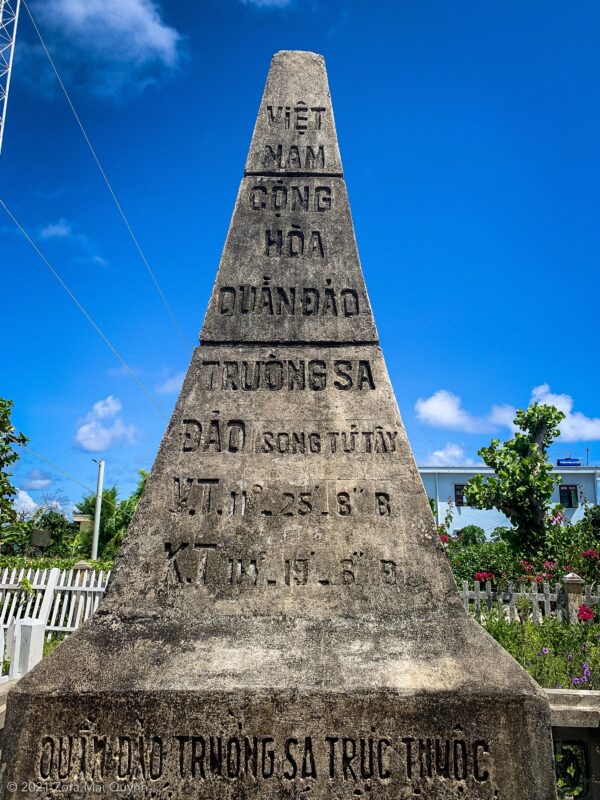**
Towards the end of the trip, with homesickness heavy in my heart, I am filled with an indescribable joy when I find myself standing at the foot of the territorial marker erected by the Republic of South Vietnam in 1956. Seeing others take pictures with the marker, I want to say, this is where I see my reflection on the islands. Sea swept on one side, its lettering is worn out, but on the other side, the etchings are clear. I run my fingers, feeling the imprint of the lettering on the block, wondering at the hands that had erected it so many decades ago.
Vào cuối chuyến đi, với nỗi nhớ nhà nặng trĩu trong lòng, một niềm vui khôn tả trào dâng trong tôi khi thấy mình đang đứng dưới chân cột mốc lãnh thổ do Cộng hòa miền Nam Việt Nam dựng lên năm 1956. Nhìn thấy người khác chụp hình cột mốc, tôi muốn nói rằng, đây là nơi tôi nhìn thấy hình ảnh của mình phản chiếu trên các hòn đảo. Một bên biển quét mòn nét chữ nhưng bên kia, nét khắc còn rõ. Tôi lướt ngón tay, cảm nhận vết khắc của nét chữ trên khối đá, và tự hỏi về những bàn tay đã dựng lên nó cách đây hàng chục năm.

Like present day Vietnam, the Republic of South Vietnam took great measures to preserve the sovereignty of the islands in the face of continuing attempts by China to forcibly occupy the islands, including attending a meteorological conference in September of 1975, nine months after April of 1975. The marker joins a multitude of historical records compiled by Vietnam to affirm their sovereignty over the islands dating back to 16th century European maps and maps and documents from Vietnam’s antiquity.
Cũng giống như Việt Nam ngày nay, Cộng hòa miền Nam Việt Nam đã có những biện pháp hữu hiệu để bảo vệ chủ quyền quần đảo trước những nỗ lực liên tục của Trung Quốc để chiếm đóng các đảo bằng vũ lực, kể cả việc tham dự một hội nghị khí tượng vào tháng 9 năm 1975, chín tháng sau tháng 4 năm 1975. Cột mốc này được đưa vào vô số các sử liệu do Việt Nam biên soạn để khẳng định chủ quyền về quần đảo từ thế kỷ 16 của Châu u và các bản đồ và tài liệu thời cổ đại của Việt Nam.
Video: Territorial Marker of Republic of South Vietnam | Điểm đánh dấu lãnh thổ do Cộng hòa miền Nam Việt Nam
Vietnam’s struggle for sovereignty has more than just regional implications. What is at stake is maritime freedom for an area that is a critical artery for over five trillion dollars of goods annually. Clothes, food, resources, many things we consider basic necessities – over a third of the world’s global trade – passes through the area.
Cuộc đấu tranh giành chủ quyền của Việt Nam không chỉ có ý nghĩa trong khu vực. Điều bị đe dọa là tự do hàng hải cho một khu vực là huyết mạch quan trọng với hơn 5 nghìn tỷ đô la hàng hóa hàng năm. Quần áo, thực phẩm, tài nguyên, nhiều thứ mà chúng ta coi là nhu yếu phẩm – hơn một phần ba thương mại toàn cầu – đi qua khu vực này.
But even more important than stuff – what is at stake is peace. And not just for the Asian countries involved. For Americans too. The U.S. is a long-time guarantor of freedom of maritime travel in the South Pacific with standing agreements such as the 1951 Mutual Defense Treaty with the Philippines.
Nhưng còn quan trọng hơn cả những hàng hoá – thứ đang bị đe dọa là hòa bình. Và không chỉ đối với các quốc gia Châu Á có liên quan– đối với Mỹ cũng vậy. Từ lâu Hoa Kỳ là người bảo đảm quyền tự do hàng hải ở Nam Thái Bình Dương với các thỏa thuận thường trực như Hiệp ước Phòng thủ chung năm 1951 với Philippines.

In this we, at least, have some certainty. For in matters of war and peace, the sea has ceded her control to us.
Về vấn đề này, ít nhất chúng tôi có vài điều chắc chắn. Đối với các vấn đề chiến tranh và hòa bình, biển đã nhường quyền điều khiển cho chúng ta.
 Zora Mai Quỳnh is an award-winning writer, dancer, visual artist, and performance artist whose stories, essays, and poems appear in Ploughshares, diacritics, Kweli Journal and Strange Horizons. Zora is the winner of the 2021 San Francisco Foundation Nomadic Press Literary Award. You can find Zora sipping boba at zmquynh.com or at @zmquynh on twitter, facebook, and instagram.
Zora Mai Quỳnh is an award-winning writer, dancer, visual artist, and performance artist whose stories, essays, and poems appear in Ploughshares, diacritics, Kweli Journal and Strange Horizons. Zora is the winner of the 2021 San Francisco Foundation Nomadic Press Literary Award. You can find Zora sipping boba at zmquynh.com or at @zmquynh on twitter, facebook, and instagram.
 Born and raised in Sài Gòn, BeBe Khuê Jacobs moved to New York in her teens. Graduated from the University of Virginia with an M.A. in Architecture, she helped build a new city in Vietnam called “Saigon South.” A perennial artist, she managed an animation studio, served as art curator for the City of Los Angeles, and freelances as a photographer. Passionate about writing, her many projects include a memoir detailing her childhood under Communist Vietnam, writing poetry, and translating her grandmother’s Vietnamese poems into English verse and visual art.
Born and raised in Sài Gòn, BeBe Khuê Jacobs moved to New York in her teens. Graduated from the University of Virginia with an M.A. in Architecture, she helped build a new city in Vietnam called “Saigon South.” A perennial artist, she managed an animation studio, served as art curator for the City of Los Angeles, and freelances as a photographer. Passionate about writing, her many projects include a memoir detailing her childhood under Communist Vietnam, writing poetry, and translating her grandmother’s Vietnamese poems into English verse and visual art.
 Nguyễn Quốc Hùng was a translator, working in the United States Information Service press office in Sài Gòn during the war, and as a broadcaster for Voice of America in Washington, D.C. in the ‘70s where he translated the news into Vietnamese for live broadcasting. He and BeBe are inspired by his mother, Đào Thị Quỳ, a poet and writer whose diasporic work reflects her uprootment from Hà Nội to Sài Gòn in 1951, and then from Sài Gòn to Houston, Texas in 1982.
Nguyễn Quốc Hùng was a translator, working in the United States Information Service press office in Sài Gòn during the war, and as a broadcaster for Voice of America in Washington, D.C. in the ‘70s where he translated the news into Vietnamese for live broadcasting. He and BeBe are inspired by his mother, Đào Thị Quỳ, a poet and writer whose diasporic work reflects her uprootment from Hà Nội to Sài Gòn in 1951, and then from Sài Gòn to Houston, Texas in 1982.


